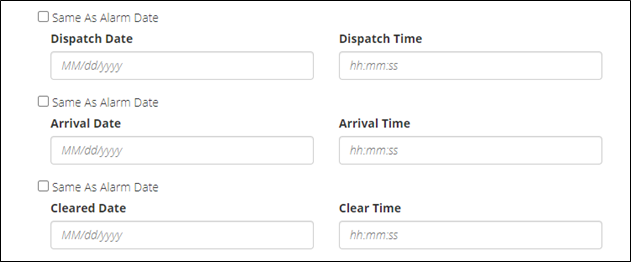Dates and Times
Posted: June 7, 2023
This NFIRSGram helps you to complete fields related to dates and times and understand how accurately reporting this information helps fire department performance.
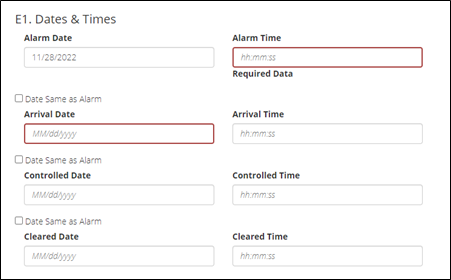
Each fire department is responsible for planning and managing its operations so that firefighters can perform their roles of fire control and fire prevention more effectively and efficiently. The availability of accurate information about when fires and other incidents occur is vital in achieving maximum performance. Patterns that emerge from the analysis of incident data can help departments focus on current problems, predict future problems in their communities, and measure their programs’ performance.
The collection of dates and times in the National Fire Incident Reporting System (NFIRS) provides the fire department with the data needed to determine when incident types occur in your district, such as the time of day or day of week. This information also allows determination of how long it takes the fire department to arrive on the scene of the incident, sometimes known as travel time, and how long the fire department operates on each different type of incident.
Important points about dates and times
- All dates and times are entered as numerals. For time of day, the 24-hour clock is used, where midnight is expressed as 00:00. Many automated systems provide times formatted in hours, minutes and seconds, such as 12:34:56. The collection of seconds is optional and not required; however, NFIRS supports the collection of times in this format.
- The Alarm Date and Time is not the time that the Public Service Communications Center received a call from the public. Instead, it should reflect the time when the fire department was notified of the emergency.
- Alarm Date and Time is important for 3 reasons:
- As a legal requirement for recording the precise time that notification was made of the incident.
- As information for determining the frequency of types of incidents by time period.
- As the starting time to determine the length of time taken to arrive at an incident and the total amount of time spent on the incident scene, also referred to as the “vertical response time.” Learn more about incident response time PDF.
- Last Unit Cleared Date and Time is the actual month, day, year and time of day when the last unit cleared the incident scene.
- Last Unit Cleared Date and Time does not reflect an “in service” time, but it does include the time spent transporting a patient to a hospital facility.
- An Arrival Date and Time is not required for calls where the fire department was canceled prior to arrival, since no units from the department arrived on the scene of the reported incident. The Incident Type Code for this call is 611 – Dispatched and Canceled en Route.
- The times entered on the Apparatus Module should be unit specific.
Date and time fields explained
- Alarm Date and Time
- This is the actual month, day, year and time of day when the alarm was received by the fire department.
The Alarm Date and Time is not the time that the Public Service Communications Center received a call from the public, but the time that the Communications Center dispatched or alerted the fire department units that they had an incident to which they should respond. The Alarm Date will always be the same date as the Incident Date entered in Section A — Key Information.
Alarm Date and Time is important for 3 reasons:
- As a legal requirement for recording the precise time a notification was made of the incident.
- As information for determining the frequency of types of incidents by time period.
- As the starting time to determine the length of time taken to arrive at an incident and the total amount of time spent on the incident scene.
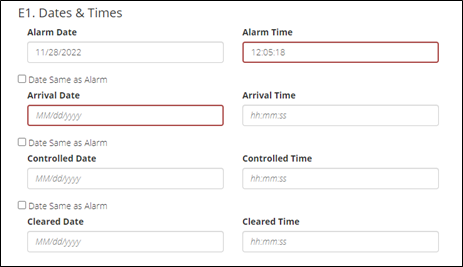
- Arrival Date and Time
- This is the actual month, day, year and time of day when the first responding unit for the reporting fire department arrived at the incident scene.
The Arrival Date and Time fields reflect the time spent traveling to the scene of the incident. This information can be useful to fire department management in determining the actual time spent at an incident and any delay between alarm and arrival.
If the Arrival Date is the same as the Alarm Date, the report writer can check the box, “Date Same as Alarm.”
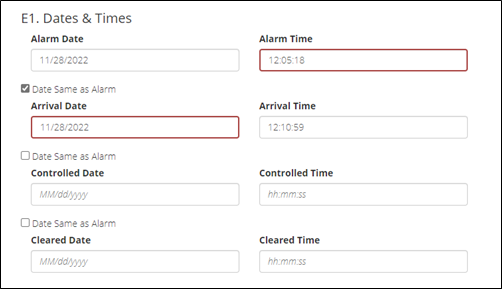
- Controlled Date and Time
- This is the actual month, day, year and time of day when the fire was brought under control, or the incident was stabilized and did not require additional emergency resources.
“Controlled” is the time when the Incident Commander determined that the fire would not escape from its containment perimeter. This field is required for wildland fires — Incident Type 142. However, it can be used for all fire types.
The time spent stabilizing a fire provides fire department management with the information needed to analyze the duration patterns of different types of fires. This can assist in determining service demands and costs for resource allocation.
If the fire is out upon arrival, the Controlled Time is the same as the Arrival Time. If the Controlled Date is the same as the Alarm Date, the report writer can check the box, “Date Same as Alarm.”
- Last Unit Cleared Date and Time
- This is the actual month, day, year and time of day when the last unit of the reporting fire department cleared the incident scene.
Last Unit Cleared Date and Time fields do not reflect an “in service” time, however, they do include the time spent transporting a patient to a hospital facility.
If the Last Unit Cleared Date is the same as the Alarm Date, the report writer can check the box, “Date Same as Alarm.”
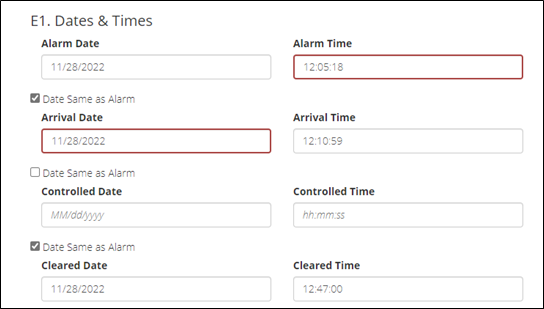
Dates and times for incidents where the fire department was canceled
(while still en route to the incident address)
When a fire department is dispatched on an incident, but is canceled prior to arriving on the scene, the incident should be coded with Incident Type Code 611 — Canceled en route, and the Alarm Date and Time should be entered, as well as the Last Unit Cleared Date and Time. The Arrival Date and Time should be left blank since no units from the department arrived on the scene of the reported incident.
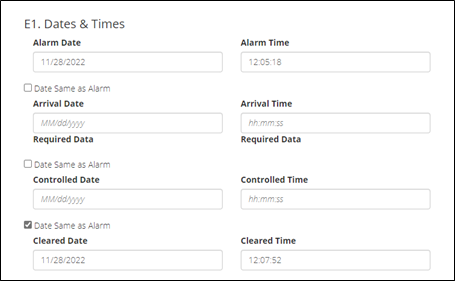
Dates and times on the Apparatus and Personnel Modules
The Apparatus and Personnel Modules offer departments the opportunity to track the response time of individual units. This is especially helpful when your department (as a matter of policy) dispatches multiple units based upon the incident type reported by the public, but upon arrival, finds that all the units are not needed, and the first arriving unit cancels the remaining units.
The times entered on these modules should be unit specific. If a unit is dispatched on an incident, and another unit cancels them prior to their arrival, they would only need to enter the Dispatch Date and Time and the Clear Date and Time on the Apparatus Module. They would then need to enter the Actions Taken Code 93 — Canceled en route, to denote that this unit was canceled prior to arriving on the scene. This is especially important if the unit is canceled by the Communications Center prior to any unit arriving on the scene.
